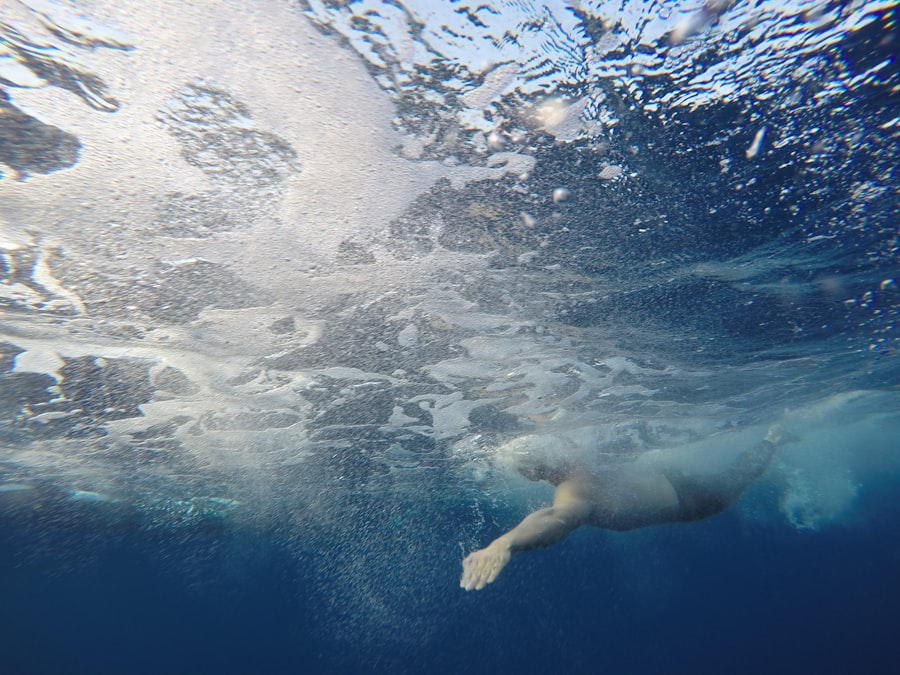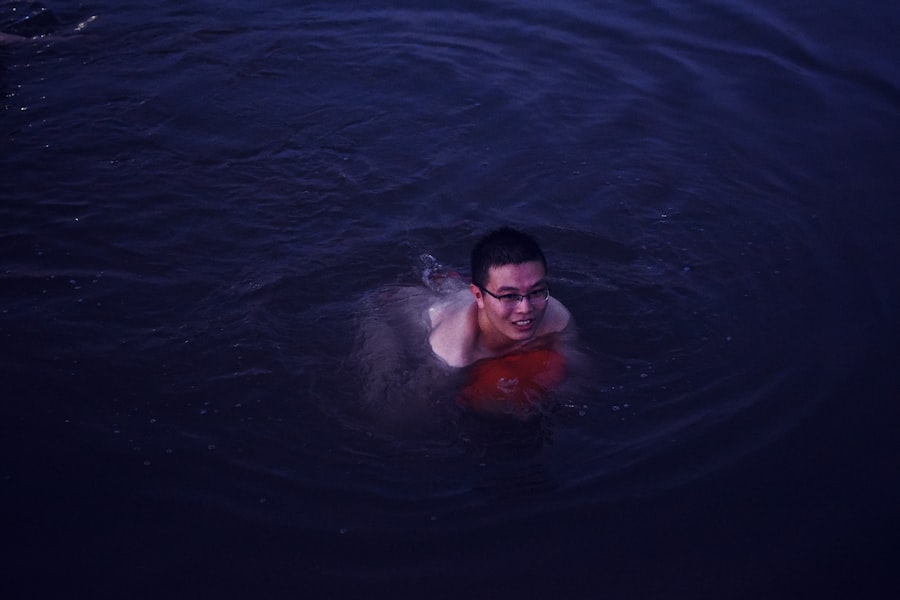The Drake Passage, a body of water that separates South America from Antarctica, is renowned for its tumultuous seas and unpredictable weather. Stretching approximately 600 miles, this passage is not only a critical route for maritime navigation but also a formidable challenge for adventurers seeking to test their limits. The waters are often characterized by strong currents, high waves, and rapidly changing conditions, making it one of the most treacherous stretches of ocean in the world.
For those daring enough to attempt a swim across this formidable expanse, the Drake Passage represents the ultimate test of endurance and resilience. The allure of the Drake Passage lies not only in its challenges but also in its breathtaking natural beauty. The surrounding landscapes are stark and dramatic, with towering icebergs and rugged coastlines that evoke a sense of awe.
The passage serves as a gateway to the pristine wilderness of Antarctica, drawing explorers and nature enthusiasts alike. As such, it has become a symbol of adventure, embodying the spirit of exploration that has captivated humanity for centuries. For swimmers, the Drake Passage is not merely a physical challenge; it is an opportunity to connect with nature in its rawest form.
Key Takeaways
- The Drake Passage is a treacherous body of water located between South America’s Cape Horn and the South Shetland Islands of Antarctica.
- The history of the Drake Passage is filled with tales of exploration, shipwrecks, and scientific discovery.
- Swimming the Drake Passage presents numerous challenges, including frigid temperatures, strong currents, and unpredictable weather conditions.
- Proper training for the Drake Passage swim involves rigorous physical conditioning, cold water acclimatization, and mental preparation for the extreme conditions.
- Essential gear and equipment for the Drake Passage swim include specialized wetsuits, navigation aids, emergency supplies, and a support team for safety and logistics.
The History of the Drake Passage
The history of the Drake Passage is steeped in exploration and discovery. Named after Sir Francis Drake, the English sea captain who navigated these waters in the late 16th century, the passage has long been a focal point for maritime endeavors. Drake’s journey marked one of the first recorded crossings, paving the way for future explorers who sought to chart the unknown territories of the Southern Hemisphere.
Over the centuries, the passage has witnessed countless voyages, from whaling expeditions to scientific research missions, each contributing to our understanding of this remote region. In addition to its historical significance, the Drake Passage has played a crucial role in shaping global trade routes. As ships began to navigate these waters more frequently, they encountered both peril and opportunity.
The passage became a vital link between the Atlantic and Pacific Oceans, facilitating commerce and cultural exchange. However, it also earned a reputation for its fierce storms and unpredictable conditions, leading many sailors to regard it with a mix of respect and trepidation. This duality of danger and opportunity continues to define the Drake Passage today.
The Challenges of Swimming the Drake Passage

Swimming the Drake Passage is an endeavor that few would dare to undertake, and for good reason. The challenges presented by this body of water are immense, with frigid temperatures and powerful currents posing significant risks to even the most experienced swimmers. The average water temperature hovers around 32 degrees Fahrenheit, which can lead to rapid hypothermia if proper precautions are not taken.
Additionally, the unpredictable weather patterns can create treacherous conditions that change within minutes, making it essential for swimmers to be prepared for anything. Beyond the physical challenges, there are also psychological hurdles to overcome. The vastness of the ocean can evoke feelings of isolation and vulnerability, testing one’s mental fortitude.
Swimmers must contend with not only their own fears but also the inherent dangers posed by marine life and shifting weather patterns. The combination of these factors makes swimming the Drake Passage an extraordinary feat that requires not only physical strength but also unwavering determination and mental resilience.
Training for the Drake Passage Swim
| Participant | Distance Swam (miles) | Training Hours | Average Speed (mph) |
|---|---|---|---|
| John Smith | 150 | 50 | 3 |
| Sarah Johnson | 200 | 60 | 3.33 |
| Michael Brown | 180 | 55 | 3.27 |
Preparing for a swim across the Drake Passage demands rigorous training and meticulous planning. Swimmers must build their endurance through a combination of long-distance swimming sessions and strength training exercises. This preparation often involves swimming in cold water environments to acclimatize the body to low temperatures, as well as incorporating interval training to enhance speed and stamina.
Many swimmers also engage in cross-training activities such as running or cycling to improve overall fitness levels. In addition to physical training, swimmers must develop specific skills tailored to the unique challenges of the Drake Passage. This includes mastering techniques for navigating rough waters and understanding how to manage energy expenditure during long swims.
Many aspiring swimmers seek guidance from experienced coaches or mentors who have successfully completed similar challenges. This mentorship can provide invaluable insights into effective training regimens and strategies for overcoming obstacles during the swim.
The Gear and Equipment Needed for the Drake Passage Swim
The right gear is essential for anyone attempting to swim the Drake Passage.
These wetsuits are often thicker than standard suits, offering additional protection against hypothermia.
In addition to wetsuits, swimmers may also use neoprene caps, gloves, and booties to further shield themselves from the frigid waters. Beyond personal gear, safety equipment plays a crucial role in ensuring a successful swim across the Drake Passage. Swimmers often rely on support boats equipped with safety gear such as life jackets, first aid kits, and communication devices.
These support teams are vital for monitoring swimmers’ conditions and providing assistance if needed. Additionally, GPS devices can help track progress and ensure that swimmers stay on course throughout their journey.
Mental Preparation for Conquering the Drake Passage

Mental preparation is as critical as physical training when it comes to swimming the Drake Passage. Swimmers must cultivate a strong mindset capable of withstanding both physical discomfort and psychological challenges. Visualization techniques can be particularly effective; by imagining themselves successfully completing the swim, athletes can bolster their confidence and reinforce their determination.
This mental rehearsal helps swimmers prepare for potential setbacks and maintain focus during difficult moments. Moreover, developing coping strategies for anxiety and stress is essential for success in such an extreme environment. Many swimmers practice mindfulness or meditation techniques to enhance their mental resilience.
These practices can help individuals remain calm under pressure and maintain clarity of thought when faced with unexpected challenges during their swim.
The Wildlife and Natural Beauty of the Drake Passage
The Drake Passage is not only known for its challenges but also for its stunning natural beauty and diverse wildlife. As swimmers traverse these waters, they may encounter an array of marine life, including seals, whales, and various species of seabirds. The sight of a humpback whale breaching or a colony of penguins basking on ice floes adds an element of wonder to the arduous journey.
This rich biodiversity serves as a reminder of the ecological significance of the region and underscores the importance of preserving its fragile ecosystems. The landscapes surrounding the Drake Passage are equally captivating. Towering glaciers and rugged cliffs create a dramatic backdrop that contrasts sharply with the deep blue waters below.
The ever-changing light conditions can transform the scenery in an instant, casting vibrant hues across the sky at sunrise or sunset. For swimmers, these moments of beauty provide motivation during challenging stretches of their journey, reminding them of the incredible adventure they are undertaking.
The Importance of Safety and Support Teams
Safety is paramount when attempting to swim across the Drake Passage, making support teams an indispensable part of any successful endeavor. These teams typically consist of experienced mariners who understand the complexities of navigating these treacherous waters. They provide essential guidance on weather conditions, currents, and potential hazards while ensuring that swimmers remain safe throughout their journey.
Support teams also play a crucial role in monitoring swimmers’ physical conditions during their swim. They are equipped to provide immediate assistance in case of emergencies, whether it be administering first aid or facilitating a quick extraction from the water if necessary. The presence of a reliable support team allows swimmers to focus on their performance without constantly worrying about their safety, creating an environment where they can push their limits while knowing help is readily available.
Successful Attempts at Swimming the Drake Passage
Despite its formidable reputation, there have been successful attempts at swimming across the Drake Passage that inspire future adventurers. One notable achievement was accomplished by swimmer Trent Grimsey in 2010 when he became the first person to complete a solo swim across this challenging expanse. His journey took over 10 hours as he battled freezing temperatures and strong currents, ultimately proving that determination and preparation can lead to extraordinary accomplishments.
Other successful attempts have followed suit, showcasing not only individual perseverance but also advancements in training techniques and safety measures. Each successful swim adds to a growing legacy of human achievement against nature’s most daunting challenges. These stories serve as motivation for aspiring swimmers who dream of conquering the Drake Passage themselves, demonstrating that with dedication and preparation, even seemingly insurmountable obstacles can be overcome.
The Impact of Climate Change on the Drake Passage
As global climate change continues to reshape our planet, its effects are increasingly felt in regions like the Drake Passage. Rising ocean temperatures and melting ice caps pose significant threats to marine ecosystems and wildlife habitats within this area. Changes in water temperature can disrupt migratory patterns for species such as whales and seals while altering food availability for seabirds that rely on specific marine life for sustenance.
Moreover, shifting weather patterns may further complicate swimming attempts across the passage in years to come. Increased storm frequency or intensity could create even more hazardous conditions for swimmers venturing into these waters. As awareness grows regarding climate change’s impact on our oceans, it becomes imperative for adventurers to consider not only their personal goals but also their responsibility toward preserving these fragile ecosystems for future generations.
The Ultimate Test of Endurance and Adventure
Swimming across the Drake Passage stands as one of humanity’s most formidable tests of endurance and adventure. It encapsulates not only physical strength but also mental resilience in facing nature’s most daunting challenges. From rigorous training regimens to meticulous planning regarding gear and safety measures, every aspect requires careful consideration by those daring enough to take on this extraordinary feat.
As adventurers continue to push boundaries in pursuit of their dreams within this breathtaking yet treacherous environment, they contribute to a legacy that celebrates human spirit and exploration. The stories born from these attempts serve as reminders that while nature may be fierce and unpredictable, it also offers unparalleled beauty and wonder waiting to be discovered by those willing to embrace its challenges head-on.
Swimming the Drake Passage is an extraordinary feat that challenges even the most seasoned adventurers due to its treacherous waters and unpredictable weather conditions. For those interested in exploring more about adventurous quests and geographical challenges, you might find the article on MyGeoQuest intriguing. It delves into various geographical explorations and quests that push the boundaries of human endurance and curiosity. You can read more about these fascinating adventures by visiting MyGeoQuest.
WATCH NOW! Drake Passage: Earth’s Deadliest Waters Revealed
FAQs
What is the Drake Passage?
The Drake Passage is the body of water between the southern tip of South America and the northern tip of the Antarctic Peninsula. It is known for its rough seas and strong winds, making it one of the most challenging and unpredictable stretches of water to navigate.
What is “Drake Passage Schwimmen”?
“Drake Passage Schwimmen” refers to the act of swimming across the Drake Passage. It is a challenging and extreme swimming endeavor that requires careful planning, preparation, and endurance due to the cold temperatures, strong currents, and unpredictable weather conditions.
Has anyone successfully swum across the Drake Passage?
As of now, there are no documented cases of anyone successfully swimming across the Drake Passage. The extreme conditions and challenges posed by the passage make it a highly risky and difficult feat to accomplish.
What are the main challenges of swimming across the Drake Passage?
The main challenges of swimming across the Drake Passage include frigid water temperatures, strong and unpredictable currents, powerful winds, potential encounters with icebergs, and the remote and inhospitable nature of the surrounding environment.
Are there organized events or expeditions for swimming across the Drake Passage?
There are no widely known organized events or expeditions specifically for swimming across the Drake Passage. Due to the extreme nature of the challenge, it is not a common or widely attempted feat.
